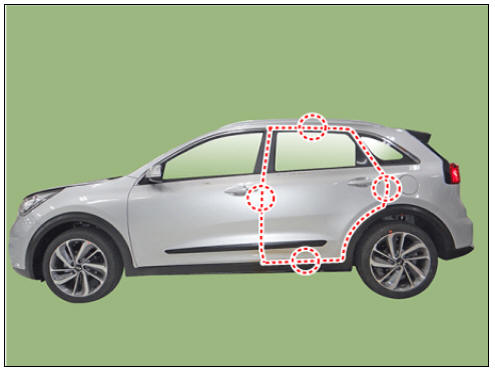KIA Niro: Rear Door / Repair Procedures

- Rear door trim
- Rear door delta inner cover
- Rear door panel & module
- Rear door delta lower run & channel
- Rear door side weatherstrip
- Rear door body side weatherstrip
- Rear door window glass run
- Rear door delta moulding
- Rear door frame molding
- Rear door belt outside weatherstrip
- Rear door belt inside weatherstrip
- Rear door inside handle cap
- Rear door pull handle cap
- Rear door hinge
Rear Door / Repair Procedures
Adjustment
Glass Adjustment
Warning
Check the glass run channel for damage or deterioration, and replace it if necessary.
- Remove the rear door trim.
(Refer to Rear Door - "Rear Door Trim")
- Remove the rear door window glass mounting hole plug (A).

- Carefully move the rear door window glass (A) until the glass mounting bolts are visible, then loosen them.

- Check that the glass moves smoothly.
Door Striker Adjustment
Warning
Make sure the door latches securely without slamming it. If necessary adjust the striker (A): The striker nuts are fixed. The striker can be fine adjusted up or down, and in or out.
- Loosen the screws (B) just enough for the striker to move.
Tightening torque : 16.7 - 21.6 N*m (1.7 - 2.2 kgf*m, 12.3 - 15.9 lb*ft)

- Tap on the striker with a plastic hammer to adjust the striker. The striker will not move much, but will give some adjustment.
- Hold the outer handle out, and push the door against the body to be sure the striker allows a flush fit. If the door latches properly, tighten the screws and recheck.
Door Position Adjustment
Warning
After installing the door, check for a flush fit with the adjacent body panels, then check for equal gaps between the front, rear, and bottom, door edges and the body. Check that the door and body edges are parallel. Before adjusting, replace the mounting bolts.
- Check that the door and body edges are parallel.

- Place the vehicle on a firm, level surface when adjusting the doors.
- Adjust at the hinges (A) :
- Loosen the door mounting bolts slightly, and move the door in or out until it aligns flush with the body.
- Loosen the hinge mounting bolts slightly, and move the door backward or forward, up or down as necessary to equalize the gaps.
- Place a shop towel on the jack to prevent damage to the door when adjusting the door.
Tightening torque :
(B) : 9.8 - 19.6 N*m (1.0 - 2.0 kgf*m, 7.2 - 14.5 lb*ft)
(C) : 33.3 - 41.2 N*m (3.4 - 4.2 kgf*m, 24.6 - 30.4 lb*ft)

- Grease the pivot portions of the hinges indicated by the arrows.
- Check for water leaks.
READ NEXT:
 Rear Door Trim
Rear Door Trim
Rear Door Trim Components and components location
Rear door trim
Rear Door Trim Repair procedures
Replacement
Remove the rear door delta inner cover (A) using a remover.
Remove the rear door inside cap (A) and then loosen th
 Rear Door Window Glass
Rear Door Window Glass
Rear Door Window Glass Components and components location
Rear door window glass
Rear Door Window Glass Repair procedures
Replacement
Remove the rear door trim.
(Refer to Rear Door - "Rear Door Trim")
Remove the rear doo
 Rear Door Module
Rear Door Module
Rear door module
Replacement
Remove the rear door window glass.
(Refer to Rear Door - "Rear Door Window Glass")
Remove the rear door channel (A) after loosening the mounting bolts and
nut.
Tightening torque :
Bolt :
SEE MORE:
 SRS Control Module (SRSCM) Repair procedures
SRS Control Module (SRSCM) Repair procedures
SRS Control Module (SRSCM) Description and operation
The primary purpose of the SRSCM (Supplemental Restraints System Control
Module) is to determine
between an event that warrants restraint system deployment and an event that
does not. The SRS
 Main Fuse Inspection | Checking for Welding in the High Voltage Main Relay
Main Fuse Inspection | Checking for Welding in the High Voltage Main Relay
Turn the ignition switch OFF and disconnect the auxiliary 12V battery negative (-) terminal.
Shut off the high voltage.
(Refer to Hybrid Control System - "High voltage Shut-off Procedures")
Remove the center tra
Categories
- Home
- KIA Niro EV, Hybrid - Second generation - (SG2) (2021-2024) - Owner's manual
- Kia Niro - First generation - (DE) (2017-2022) - Service and Repair Manual
- Contact Us
